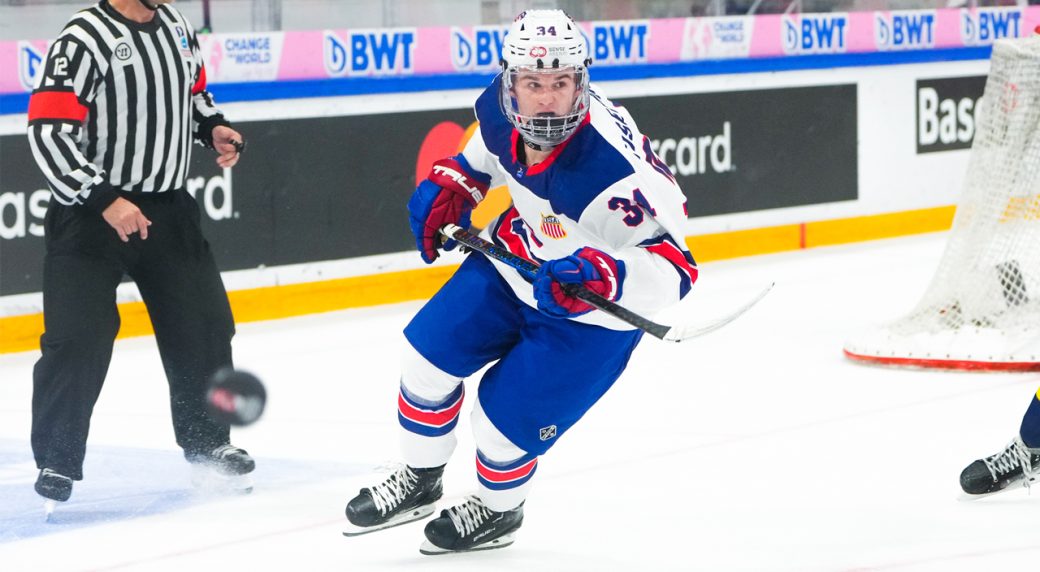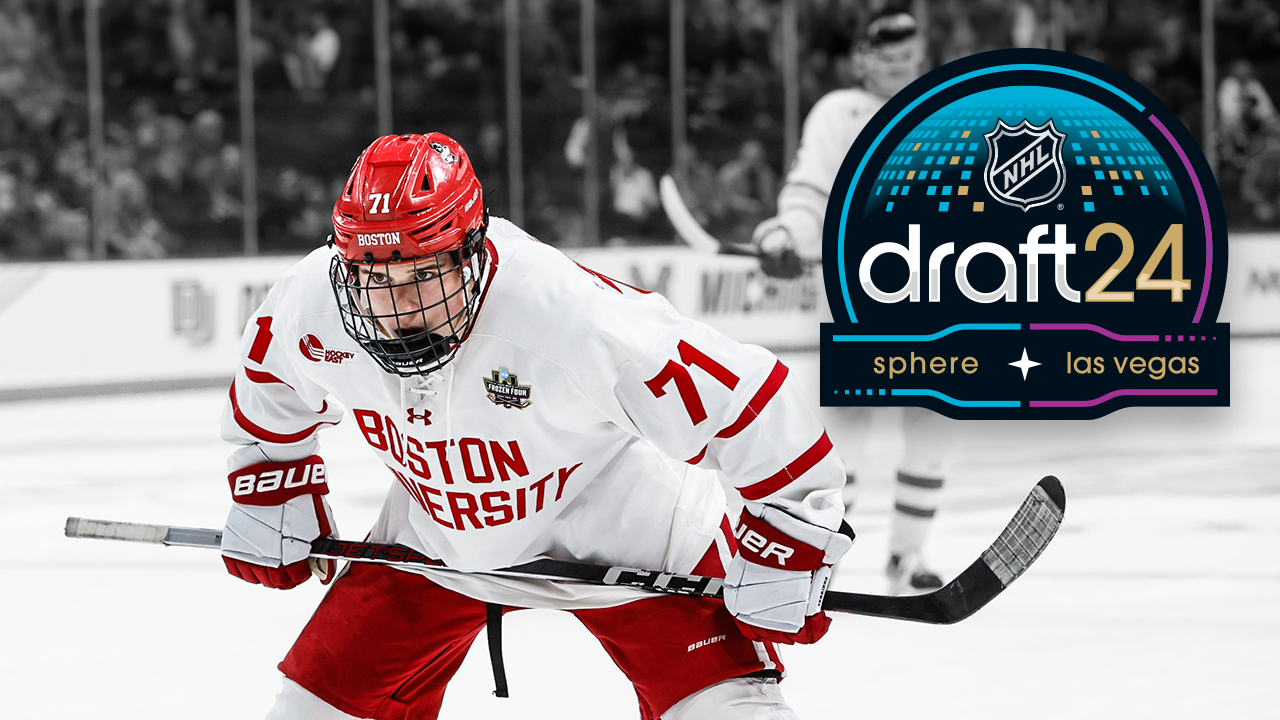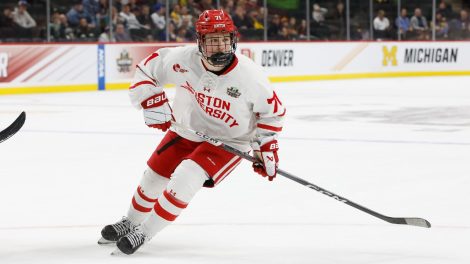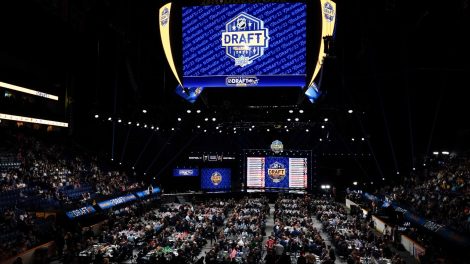Of all the goals Cole Eiserman scores, one-timers are his favourite.
“Those are the best — when you can kind of just let ‘er rip and see what happens, shoot it as hard as you can, and hope for the best,” says the winger. There’s an element of humility in his description: you need not rely too heavily on hope when you can shoot the puck as hard and as accurately as the U.S. National Team Development Program product, who’s projected to be selected in the first round of next week’s NHL Draft.
Eiserman’s one-timer — think Alex Ovechkin, but from an office at the opposite hashmarks — is just one of the many ways the 17-year-old has found the back of the net this season. The fact that it’s just one of his many weapons is why he’s considered the best pure goal-scorer in his draft class. His stats back that up, dating back to his remarkable U14 year at the prestigious Shattuck St. Mary’s AAA program in 2020-21, when he tallied 97 goals in 50 games. After his second prolific season there, he jumped into the USNTDP and immediately set a goal-per-game pace. He never slowed down, and last month wrote his name into USA Hockey’s record books with his 127th marker in his two-year span with the U17 and U18 teams, surpassing Cole Caufield’s record for most goals by a USNTDP player. (Caufield, now with the Montreal Canadiens, scored 126 with the U.S. program from 2017-2019.)
“Yeah, it’s cool. It’s something that I obviously worked pretty hard for,” says Eiserman, whose historic goal came, fittingly, courtesy of a flawless one-timer.
“I definitely want someone else to beat it,” he adds. “Obviously, it’s pretty special for me — and I want it to be special for someone else as well.”
Scoring, says USNTDP head coach Nick Fohr, is “what drives [Eiserman] to be a hockey player.” And it’s what launched him into top-three prospect projections a year ago. “He just loves to score goals, and he can do it in different ways. For me, watching him for two years and how he scores and why he scores and all those things, you know, he’s just so driven to do it. And it just comes off his stick different, right?”
According to Fohr, puck-tracking data collected during the recent U18 worlds clocked Eiserman’s maximum shot speed at over 100 miles an hour — a speed none of his teammates came close to matching in their own attempts on net.
“It’s hard, and it’s pretty accurate,” Fohr says of Eiserman’s shot, which the winger has spent his whole life honing at every opportunity — on and off the ice. The coach tells a story of one goal Eiserman scored this year that appeared not to go past the opposing goaltender so much as right through him, leaving the netminder shaking his head as he looked down at the indelible scar left by the puck on the paddle of his stick on its way to the back of the net.
“He does the hardest thing in hockey, the best,” Fohr says of Eiserman’s scoring. Only for Eiserman, the goal-scoring seems to come easily — it’s the rest of the game that poses the big challenge. His struggles defensively and away from the puck have resulted in his draft stock steadily dropping all season despite his scoring prowess, his reputation shifting from a player who knows how to score to one who only knows how to score. That’s what makes him one of the most intriguing prospects in this year’s class, and one of the toughest to predict — a true wild card, whose position on mock drafts around the hockey world has been anywhere from the low single digits to the high teens.
Fohr, who’s served on the development program coaching staff for 13 years, including as head coach for both Eiserman’s U17 and U18 seasons, has been around the game long enough to know the shift in the narrative was coming along with the draft-year microscope. And when the notes began to skew negative, he could see the effect it had on the teen, too.
“It was really, really hard on him mentally, you know, just being a young kid. Everything has always been so positive and now there’s all this negative stuff he’s reading,” Fohr says of Eiserman.
The coach admits that, from a hockey standpoint, those questions weren’t exactly unwarranted. He knew that, if left unchecked and uncorrected, those errors would only erode Eiserman’s game — and his pro potential — even more the following season and beyond. So, together, Fohr and Eiserman made a decision to address the flaws in the forward’s game head-on — even if it meant taking a hit on the draft board.
“I looked at him and I said, ‘Well, we’ve got two options, two ways to go about this.’ We can crank up your offensive opportunities and score more goals and try to bring more people on board with that — like, ‘He just scores so much, we just have to take him,’” explains Fohr. “Or, we can go the other route and just be like, ‘You know what? People can say whatever they want. I’m going to focus on becoming a better hockey player, being able to play all 200 feet of the rink, and just work on my game and trying to be better hockey player when I leave here. And it may cost me a few spots in the draft, but I want to be a better hockey player.’”
So, he asked Eiserman point-blank: “Which way do we want to go?”
Eiserman’s answer was quick and clear: He wanted to become a better all-around hockey player — even it if meant a dip in his draft stock as he focused on his weaker areas.
From there, the coach and his star player spent many hours poring over video, starting and stopping and quizzing and correcting in an effort to help the teen see the game — all 200 feet of it — through a more complete lens.
“I’d pull up a clip [of Eiserman in-game] and it would play, and then I would stop it and be like, ‘Okay, what should you do here?’” explains Fohr. “And then we’d hit play and we’d see what happened. And it would be like, ‘Okay, so you didn’t do that quite right’ — and we can learn from those situations. Or, ‘Oh yeah. Look, you did — you stopped there, and then what happened? You’re in the right spot, the puck came to you, and now we get to go play offence.’”
It wasn’t always a pretty process, Fohr notes with laugh. But the more Eiserman learned, and began implementing lessons from film to real-time action, the more in-game feedback Fohr provided, so the winger could correct and adjust on the fly. The two also talked plenty about the importance of Eiserman’s body language — how a slump on the bench after a missed opportunity or a frustration-fuelled whack of the stick following a poorly-played puck can be misconstrued.
“He was there for me the whole year, just talking about emotions and how I should be handling stuff, and obviously just trying to be a better hockey player, too,” Eiserman says of his coach. And the work is paying off.
“It’s definitely come a long way from the beginning of the year, just kind of getting better with coach and just talking to my teammates and doing different stuff,” Eiserman says of his game. “I think it’s at a spot where it still needs developing — but obviously, you know, everyone kind of needs developing. But it’s definitely gotten a lot better.”
Others around him see it, too. Eiserman and Macklin Celebrini were roommates during their shared time at Shattuck St. Mary’s and have been best friends since. The soon-to-be No. 1-overall pick believes certain elements of Eiserman’s game have gone unnoticed amid the noise of his scoring sprees and chatter about his defensive flaws.
“His physicality and his playmaking ability, those are two things I feel like he doesn’t get credit for,” Celebrini told reporters at the combine. “I’ve seen him for the last four or five years. His ability to make plays when he’s not scoring, his ability to bring energy to the team with his physicality, those are things I feel like he doesn’t get enough credit for.”
The next steps of Eiserman’s development will take place at Boston University, where he committed last fall after initially committing to Minnesota. The decision, he says, was entirely based on being closer to home — the youngest of five boys (a title he shares with his fraternal twin), he’s got a built-in support squad just a 40-minute drive from BU’s campus. He’s already started workouts at the rink since his NTDP duties wrapped up, training alongside some of the other local players, and he’s enjoying learning the ropes and adjusting to his new hockey home as he eagerly anticipates learning where he’ll land in the draft. (Whether he and Celebrini are reunited at BU will depend on whether the top pick returns for another year of NCAA hockey or jumps straight into the pros with the rebuilding San Jose Sharks.)
While it won’t be Fohr hosting Eiserman’s video sessions going forward, he hopes to see another shift in the narrative around Eiserman as the draft-year pressure subsides a little and scouts see his game with fresh eyes.
“They get it in their own mind that all he is a goal-scorer, and so they miss some of that stuff and it goes by the wayside,” says Fohr. “Is he perfect with that stuff? Is he the best guy I have at that? No, he’s not. But he’s cognizant of it now, he’s trying to do it better now.
“And he’s made strides already, he’s made gains already — that shows me that he’s got the ability to do it, the ability to learn it, and he’s willing to go do those things,” Fohr continues. “He’s in a good spot. He’s got himself surrounded with people that know what it takes to get [to the NHL] … and they’ll continue that progress with him, and hopefully he’ll get to that spot where he’s ready to step into the NHL next.”












